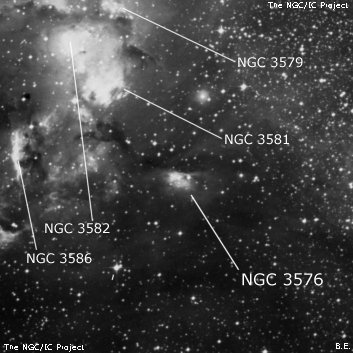
NGC 3576 is a somewhat isolated patch on the southwest side, about 5' from the main sections. At 128x and a UHC filter it appeared as a faint, circular hazy patch of low surface brightness with a mag 12.5 star at the west side and ~1.5' in diameter. NGC 3579 is a small, fan or wedge-shaped section located just to the west of larger NGC 3584. It appears 2' in size with a 12th magnitude star at the south tip and spreads to the north and west from this star. NGC 3581 is the brightest section of this complex and has sharply defined borders running SW-NE and NW-SE, meeting at a right angle about 1' WNW of mag 9.2 SAO 251313. The overall size is ~2'x1.5' with an irregular surface brightness. It is just disconnected from NGC 3582, which is close NE. NGC 3582 is another fan-shaped section which wraps around a mag 10.6 star. It has a well-defined edge running SW to NE with the northern border running E-W. The brighter star is embedded roughly in the center and several mag 13 stars are near the border. The diameter is ~2' (similar in size to NGC 3581 just SW). NGC 3584 is the furthest NE and the largest section of nebulosity. It appears as a looping arc about 3.5'x1', bowed out towards the east and extending mostly N-S and narrowing at the north end. A few mag 12 stars are off the edges. NGC 3579 appears as nearly a continuation of this loop towards the west. Finally, NGC 3586, the last in the complex, is situated ~4' SE of the center of the group of nebulae. It appears as a faint, elongated steak of 2' length oriented N-S with an 11th magnitude star about 40" NE of the north tip. The entire group was roughly sketched and easily matched up with the DSS later. NGC 3603 lies ~25' E.
John Herschel discovered NGC 3576 = h3324 on 16 Mar 1834 and recorded "F, oval. The first of a group of 6. Place by collation of diagrams." His (rough) position is too far southwest. His sketch was included in the CGH Observations, plate IV, figure 10.
Joseph Turner also sketched this group of nebulae on 19 May 1876 using the Great Melbourne Telescope (plate IV, figure 35 at www.docdb.net/history/texts/1885osngmt________e/lithograph_m_4_35.php). He sketched it noticeably elongated E-W.
400/500mm - 18" (7/7/02 - Magellan Observatory, Australia): NGC 3576 is the first of six sections in a small, but very interesting nebulous complex consisting of NGC 3576, NGC 3579, NGC 3581, NGC 3582, NGC 3584 and NGC 3586 – all situated in the same low power field with NGC 3603! The entire group is often referred to as the NGC 3576 nebular complex or the RCW 57A region.
Notes by Steve Gottlieb